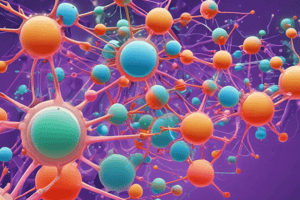Podcast
Questions and Answers
What are the different families into which cell adhesion molecules are classified based on?
What are the different families into which cell adhesion molecules are classified based on?
Their structures and functions
What are the distinct molecular characteristics exhibited by different cell adhesions?
What are the distinct molecular characteristics exhibited by different cell adhesions?
Involving unique components, ligand interactions, signaling pathways, and cytoskeletal connections
What is the common goal shared by different types of cell adhesions?
What is the common goal shared by different types of cell adhesions?
Establishing and maintaining interactions with their environment through ligand-receptor interactions, activating signaling cascades, and utilizing cytoskeletal links
What is the role of tight junctions in tissues, particularly epithelia?
What is the role of tight junctions in tissues, particularly epithelia?
How do adherens junctions contribute to cell-cell adhesion and tissue cohesion?
How do adherens junctions contribute to cell-cell adhesion and tissue cohesion?
What is the role of desmosomes in tissues?
What is the role of desmosomes in tissues?
Which molecules characterize desmosomes?
Which molecules characterize desmosomes?
What are the roles of adhesion structures and junctions in tissues?
What are the roles of adhesion structures and junctions in tissues?
What are the physiological processes in which adhesion molecules play important roles?
What are the physiological processes in which adhesion molecules play important roles?
What are gap junctions?
What are gap junctions?
What is the function of focal adhesions?
What is the function of focal adhesions?
How do adhesion structures contribute to the overall homeostasis and functionality of epithelial tissues?
How do adhesion structures contribute to the overall homeostasis and functionality of epithelial tissues?
What experimental techniques have been instrumental in elucidating protein-protein interactions involved in adhesion?
What experimental techniques have been instrumental in elucidating protein-protein interactions involved in adhesion?
What type of information do crystallography and nuclear magnetic resonance (NMR) spectroscopy provide regarding adhesion molecules?
What type of information do crystallography and nuclear magnetic resonance (NMR) spectroscopy provide regarding adhesion molecules?
What have live-cell imaging techniques, such as total internal reflection fluorescence (TIRF) microscopy, allowed researchers to visualize?
What have live-cell imaging techniques, such as total internal reflection fluorescence (TIRF) microscopy, allowed researchers to visualize?
What is the role of adhesion molecules and their interacting partners in cell lysates?
What is the role of adhesion molecules and their interacting partners in cell lysates?
What is the main function of integrins in focal adhesions?
What is the main function of integrins in focal adhesions?
How do gap junctions enable direct communication between adjacent cells?
How do gap junctions enable direct communication between adjacent cells?
Flashcards are hidden until you start studying
Study Notes
Cell Adhesion Molecules
- Cell adhesion molecules are classified into different families based on their structure, function, and molecular characteristics.
- Each family of cell adhesion molecules exhibits distinct molecular characteristics, such as specific protein domains and binding properties.
Common Goal of Cell Adhesions
- The common goal shared by different types of cell adhesions is to establish and maintain cell-cell adhesion and tissue cohesion.
Tight Junctions
- Tight junctions play a crucial role in tissues, particularly epithelia, by forming a barrier to regulate the movement of molecules and ions across the epithelial layer.
- They also help to maintain cell polarity and tissue organization.
Adherens Junctions
- Adherens junctions contribute to cell-cell adhesion and tissue cohesion by forming strong, adhesive interactions between adjacent cells.
- They are essential for maintaining tissue integrity and preventing cell detachment.
Desmosomes
- Desmosomes play a critical role in tissues by providing mechanical strength and stability to tissues.
- They are characterized by the presence of specific molecules, such as desmogleins and desmocollins, which facilitate cell-cell adhesion.
Adhesion Structures and Junctions
- Adhesion structures and junctions play a crucial role in tissues by providing mechanical strength, regulating cell-cell adhesion, and maintaining tissue organization and cohesion.
- They are essential for maintaining tissue homeostasis and functionality.
Physiological Processes
- Adhesion molecules play important roles in various physiological processes, including embryonic development, tissue regeneration, and immune responses.
Gap Junctions
- Gap junctions are specialized channels that enable direct communication between adjacent cells by allowing the exchange of ions, metabolites, and signaling molecules.
- They play a crucial role in coordinating cellular responses and maintaining tissue homeostasis.
Focal Adhesions
- Focal adhesions are small, dynamic structures that form at the interface between cells and the extracellular matrix.
- They play a crucial role in regulating cell migration, proliferation, and survival by providing a mechanical link between the cell and the extracellular matrix.
Integrins
- Integrins are a family of transmembrane receptors that play a crucial role in focal adhesions by providing a mechanical link between the cell and the extracellular matrix.
- They regulate cell migration, proliferation, and survival by transmitting signals from the extracellular matrix to the cell interior.
Experimental Techniques
- Experimental techniques, such as crystallography and nuclear magnetic resonance (NMR) spectroscopy, have been instrumental in elucidating protein-protein interactions involved in adhesion.
- These techniques provide detailed information about the structure and function of adhesion molecules.
Live-Cell Imaging
- Live-cell imaging techniques, such as total internal reflection fluorescence (TIRF) microscopy, have allowed researchers to visualize the dynamics of adhesion structures and junctions in real-time.
- These techniques have provided valuable insights into the mechanisms of cell adhesion and tissue cohesion.
Adhesion Molecules in Cell Lysates
- Adhesion molecules and their interacting partners in cell lysates play a crucial role in regulating cell-cell adhesion and tissue cohesion.
- They are involved in various signaling pathways that regulate cell behavior and tissue homeostasis.
Studying That Suits You
Use AI to generate personalized quizzes and flashcards to suit your learning preferences.




